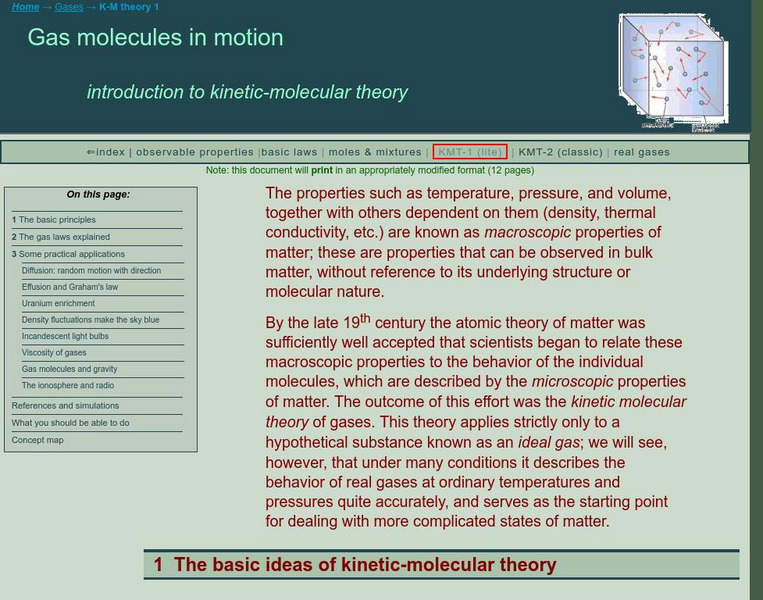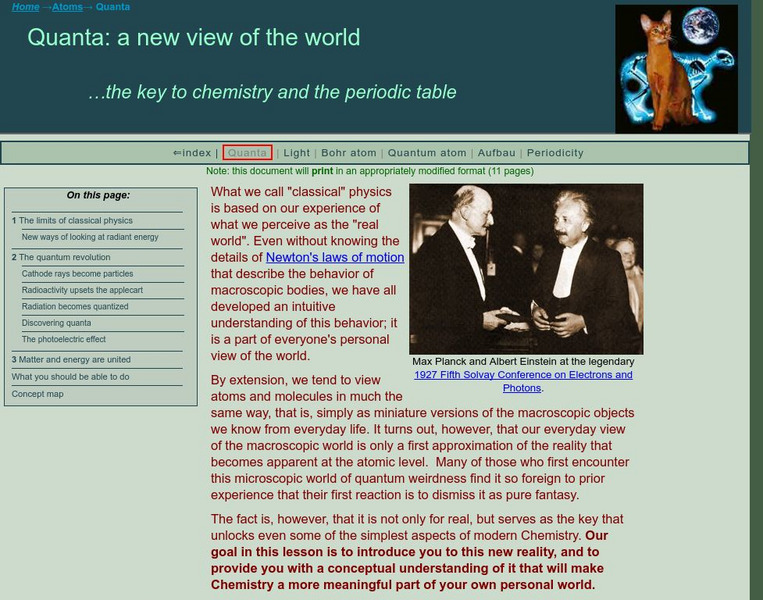Virginia Department of Education
Vapor Pressure and Colligative Properties
Hate to vacuum, but enjoy using a vacuum pump? Explore a lesson that starts with a demonstration of boiling water at various temperatures by using a vacuum pump. Then scholars design their own experiments to measure vapor pressure and...
Science Geek
The Ideal Gas Law
When doing a gas lab, you might feel under pressure. A short presentation discusses the Ideal Gas Law. It begins with the units for each variable, then describes the behavior of real gases. The lesson concludes with a comparison of...
Curated OER
Matter
In a neat and straightforward manner, this PowerPoint delivers basic introductory information on the properties of matter, physical and chemical changes, and pure substances vs. mixtures. It also defines the states of matter. For some...
Virginia Department of Education
Thermochemistry: Heat and Chemical Changes
What makes particles attract? Here, learners engage in multiple activities that fully describe colligative properties and allow the ability to critically assess the importance of these properties in daily life. Young chemists...
Virginia Department of Education
Molar Heat of Fusion for Water
How can you describe heat of fusion in a way the class understands and relates the importance of this concept to present day issues? In this third lesson of the series, learners conduct an experiment, demonstrating the flow of heat...
Virginia Department of Education
Heat Transfer and Heat Capacity
It's time to increase the heat! Young chemists demonstrate heat transfer and heat capacity in an activity-packed lab, showing the transitions between solid, liquid, and gaseous phases of materials. Individuals plot data as the...
Virginia Department of Education
The Colligative Properties of Solutions
How can you relate colligative properties of solutions to everyday situations? Pupils first discuss the concepts of density, boiling and freezing points, then demonstrate how to accurately determine the boiling and freezing point of...
Virginia Department of Education
Partial Pressure
At some point, everyone has been under pressure—even Dalton! Explore Dalton's law of partial pressures with young chemists as they measure the volume of air extracted from a sample compared to its original volume. Class...
Curated OER
Gases Worksheet
For this gases worksheet, students solve twenty problems using the gas laws and their understanding of the relationship between energy and temperature and energy and velocity.
Curated OER
States of Matter
In this states of matter instructional activity, students answer 4 questions about solids, liquids, gases and plasma. They compare the particles of each and draw diagrams showing the particles in each state of matter.
Curated OER
Heat Transfer and Pollution
Pupils perform computer simulations on air dispersion. In this chemistry lesson, students calculate energy transfer based on specific heat and temperature change. They explain the causes of smog.
Curated OER
Where My Peeps At?
Students conduct a series of activity that demonstrates Charles' and Boyle's Law. In this chemistry lesson plan, students determine the relationship among pressure, volume and temperature. They solve problems using mathematical...
Curated OER
Phases of Matter
In this matter worksheet, young scholars calculate volume and partial pressure for gases, compare liquid and vapor phases, and review the characteristics properties of gases. This worksheet has 12 multiple choice and 3 problems to solve.
Curated OER
What is a Gas?
Students develop a scientific model of gas behavior. In this gas lesson plan, students observe different balloons filled with different densities of gases. They complete an activity where they model the behavior of gases using marbles, a...
Curated OER
Solids
In this solids worksheet, students review terms associated with solid matter including, freezing and melting point, viscosity, and Brownian motion. This worksheet has 1 short answer and 14 matching questions.
Texas Education Agency
Texas Gateway: Kinetic Molecular Theory
[Accessible by TX Educators. Free Registration/Login Required] This resources allows students to explore the postulates of the Kinetic Molecular Theory in order to better understand why gas particles behave the way that they do.
Davidson College
Davidson College: Kinetic Molecular Theory: Basic Concepts
Discusses the basic concepts of kinetic molecular theory and presents animations illustrating the behavior of molecules in a closed box. Requires Java.
Other
Kinetic Molecular Theory [Pdf]
This PDF is fill in the blank notes, activities and graphic organizers on kinetic molecular theory.
State University of New York
State University of New York: Kinetic Molecular Theory
This module simulates the behavior of a small number of gas molecules in a small box.
Texas Education Agency
Texas Gateway: Atomic and Molecular Explanation of Pressure and Temperature
Learn how to calculate the kinetic energy of a gas molecule, describe the relationship between the temperature of a gas and the kinetic energy of atoms and molecule, and describe the distribution of speeds of molecules in a gas. The...
Simon Fraser University
Chem1 Virtual Textbook: Kinetic Molecular Model
The General Chemistry Virtual Textbook, or Chem 1, is broken into several sections covering various aspects of topics related to chemistry. This section deals with the basic components of the Kinetic-Molecular Theory in addition to...
Simon Fraser University
Chem1 Virtual Textbook: The Limits of Classical Physics
Acting as a subtopic of the General Chemistry Virtual Textbook's section on Atoms and the Periodic Table, this site discusses the limits associated with classical physics. Topics covered include light and heat with additional information...
CK-12 Foundation
Ck 12: Liquids
[Free Registration/Login may be required to access all resource tools.] In the following online tutorial students will describe a liquid according to the kinetic-molecular theory. They will also learn how a liquid exhibits surface...
Texas Education Agency
Texas Gateway: Kinetic Theory: Atomic & Molecular Explanation of Pressure & Temp
By the end of this section, you will be able to express the ideal gas law in terms of molecular mass and velocity; define thermal energy; calculate the kinetic energy of a gas molecule, given its temperature; describe the relationship...


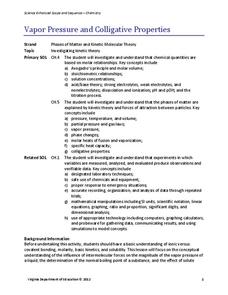
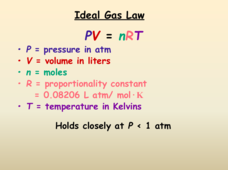
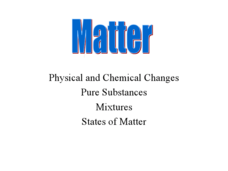









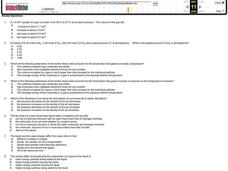



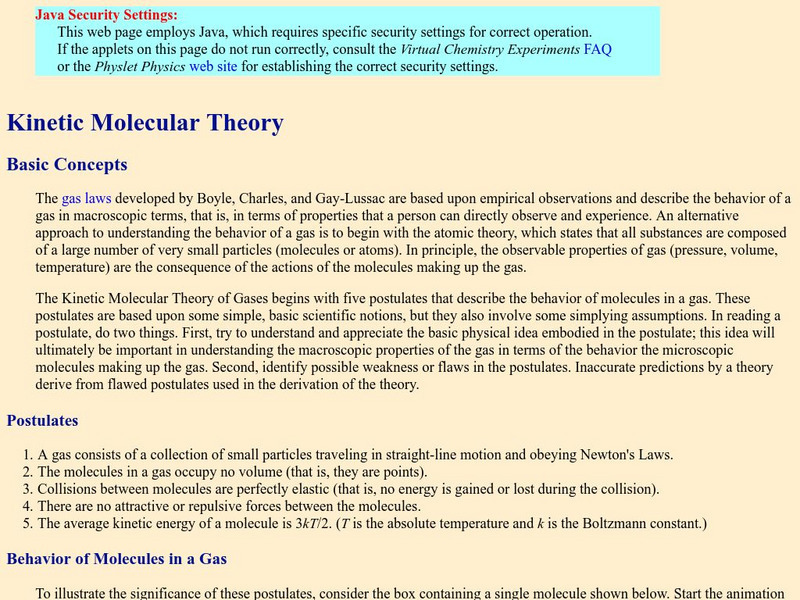
![Kinetic Molecular Theory [Pdf] Unit Plan Kinetic Molecular Theory [Pdf] Unit Plan](https://d15y2dacu3jp90.cloudfront.net/images/attachment_defaults/resource/large/FPO-knovation.png)


